When it comes to maximizing your motorcycle's performance, understanding the key factors at play is essential. You might think that engine power is all that matters, but there are several other elements that can greatly influence your ride. From selecting the right tires to maintaining proper weight distribution, each decision you make can enhance your overall experience. Curious about how simple adjustments can transform your motorcycle's capabilities? Let's explore these tips and uncover what could take your riding to the next level.
Key Takeaways
- Ensure proper engine specifications and fuel quality to maximize combustion efficiency and overall performance.
- Regularly adjust suspension settings based on rider weight and style for improved handling and stability.
- Select appropriate tires based on riding conditions and style to enhance grip and maneuverability.
- Optimize weight distribution through body positioning and cargo management for better cornering and braking stability.
Engine Specifications
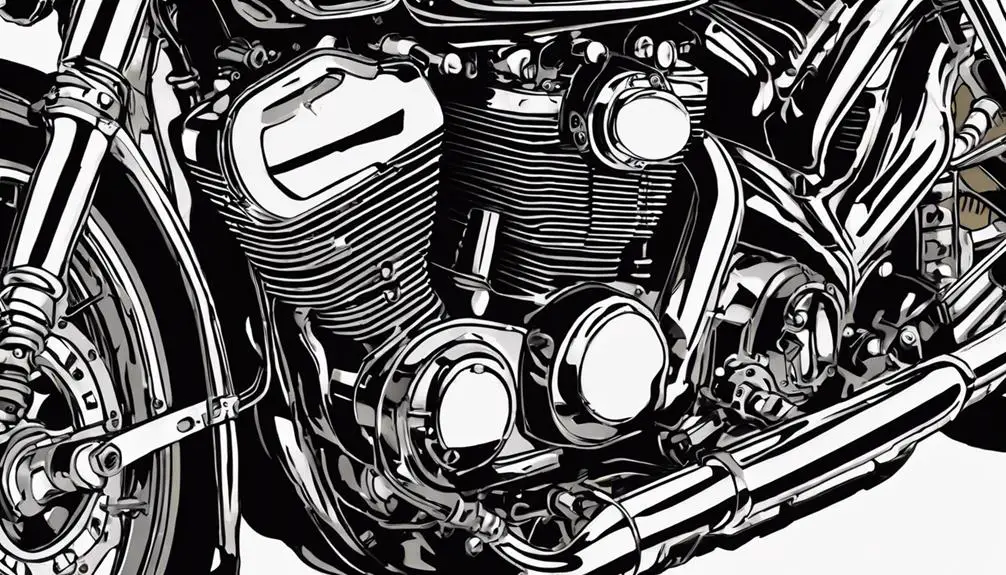
Understanding your motorcycle's engine specifications can greatly enhance your riding experience and performance. When you know the ins and outs of your engine, you can reveal the true potential of your bike.
Start by familiarizing yourself with the engine displacement—this number indicates the size and power of your engine. Larger displacements often mean more torque and acceleration, giving you that thrilling rush on the open road.
Pay attention to the horsepower and torque ratings, as these figures dictate how your bike responds at various speeds. Higher horsepower leads to faster top speeds, while torque gives you that exhilarating pull during acceleration.
You'll also want to understand the type of fuel your engine requires. Premium fuel can maximize performance for certain models, so don't skimp on quality.
Lastly, consider the engine configuration—whether it's a single-cylinder, V-twin, or inline-four. Each layout offers a unique riding character, influencing how your bike feels and performs.
Weight Distribution
Weight distribution plays an essential role in how your motorcycle handles on the road.
When you understand the balance between front and rear suspension, you'll notice significant improvements in stability and cornering.
Adjusting your weight can make all the difference in your riding experience.
Impact on Handling
Proper weight distribution on your motorcycle can dramatically enhance your handling, making it easier to maneuver through corners and maintain stability. When you shift your weight correctly, you'll feel an exhilarating connection to the road that liberates your riding experience.
Here are three key factors to take into account for ideal weight distribution:
- Body Position: Your body should lean into the turn. This shifts your center of gravity, allowing the bike to grip the road better and respond to your inputs with precision.
- Load Management: Make certain any cargo is secured and positioned low and close to the bike's center. This minimizes the bike's tendency to tip and keeps you grounded.
- Braking Technique: Modulate your brake pressure to prevent weight from shifting forward abruptly. Smooth braking maintains better stability, allowing you to tackle corners with confidence.
Suspension Balance Importance
Achieving suspension balance is essential for maximizing your motorcycle's performance and ensuring a smooth ride. When you distribute weight correctly, you enhance stability and control, allowing for a more liberated experience on the open road. Imbalances can lead to uneven tire wear, reduced traction, and unpredictable handling, which can stifle your freedom to ride confidently.
To find that sweet spot, start by adjusting your suspension settings. This includes preload, compression, and rebound, tailored to your weight and riding style. Remember, every rider is unique; what works for you mightn't suit someone else. Experiment with different settings until you feel that perfect connection with your bike.
Additionally, keep an eye on your body position while riding. Staying centered can greatly affect weight distribution, especially during turns. Leaning too far forward or backward can compromise your suspension balance, making your ride less enjoyable.
Ultimately, a well-balanced suspension system transforms your motorcycle into an extension of yourself, giving you the freedom to tackle any road with confidence and grace. Embrace the journey, and let your bike perform at its best!
Tire Selection
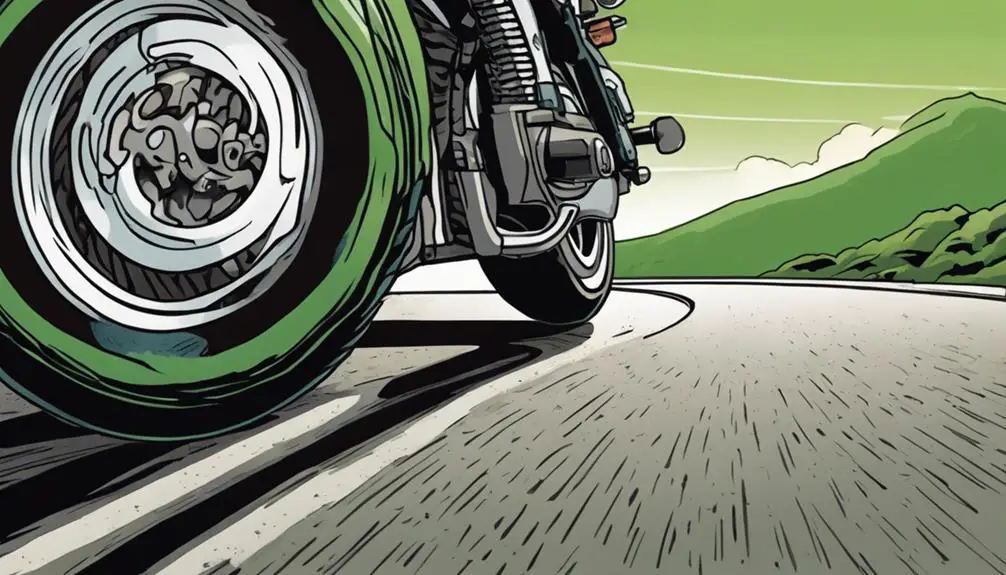
Choosing the right tires can greatly enhance your motorcycle's handling and performance on the road. They're your only contact with the pavement, so selecting tires that align with your riding style is vital.
Here are three key factors to take into account when choosing tires:
- Tread Pattern: Look for a tread pattern that matches your riding conditions. If you ride mostly on wet roads, opt for tires with deeper grooves for better water displacement. For dry conditions, a slicker tread can offer enhanced grip.
- Tire Compound: Softer compounds provide better grip but wear out faster. If you crave performance and plan to push your bike to the limit, softer tires are the way to go. For more durability and longer life, harder compounds are ideal.
- Size and Fit: Verify that the tire size fits your motorcycle's specifications. An incorrect size can affect handling and stability, so always refer to your owner's manual.
Your tire choice can liberate your riding experience, giving you the confidence to tackle any road. Embrace the freedom of the ride by investing time in selecting the perfect tires for your motorcycle.
Suspension Setup
When it comes to your motorcycle's performance, suspension setup plays an important role.
You'll need to understand the different types of suspension and how to adjust the ride height for best handling.
Let's explore these essential points to enhance your riding experience.
Suspension Types Explained
Understanding the different types of motorcycle suspension can greatly enhance your riding experience and improve overall performance. Each suspension type has unique characteristics, influencing how your bike handles bumps, corners, and speed.
Here's a breakdown of the most common suspension types:
- Telescopic Forks: These are the most common front suspension systems. They provide a smooth ride and are easy to maintain, making them a popular choice for street bikes.
- Mono-shock: Found mostly in sport and off-road bikes, the mono-shock system offers superior handling and stability. It compresses and rebounds efficiently, giving you more control during aggressive rides.
- Dual Shock: Often seen on cruisers, dual shock systems provide a plush ride, absorbing shocks well. However, they may not be as responsive as other setups, especially during high-speed maneuvers.
Choosing the right suspension type for your motorcycle can transform your ride, offering you the freedom and confidence to conquer any road.
With a solid understanding of these options, you can tailor your bike's performance to match your riding style and desires, setting you on a path to liberation.
Adjusting Ride Height
Adjusting your motorcycle's ride height can greatly influence handling, comfort, and overall performance on the road.
Whether you're carving through corners or cruising down the highway, the right ride height allows you to feel free and in control. A higher ride height can enhance cornering, giving you better lean angles and responsiveness, while lowering your bike can improve stability and comfort during long rides.
To adjust your ride height, start by considering your riding style. If you love aggressive turns, raising the rear can help you achieve sharper angles. On the other hand, if you prefer a smoother ride, lowering the front may reduce harshness on bumpy roads.
Remember, adjusting ride height isn't just about performance; it's also about your connection with the bike. A well-set ride height guarantees you can touch the ground confidently, boosting your confidence and liberation on the road.
To tweak the height, you might need to adjust the preload on your suspension or invest in aftermarket components. Always take your time to fine-tune it, as the right setup can make all the difference in your riding experience.
Embrace the freedom that comes with a well-adjusted ride!
Fuel Quality
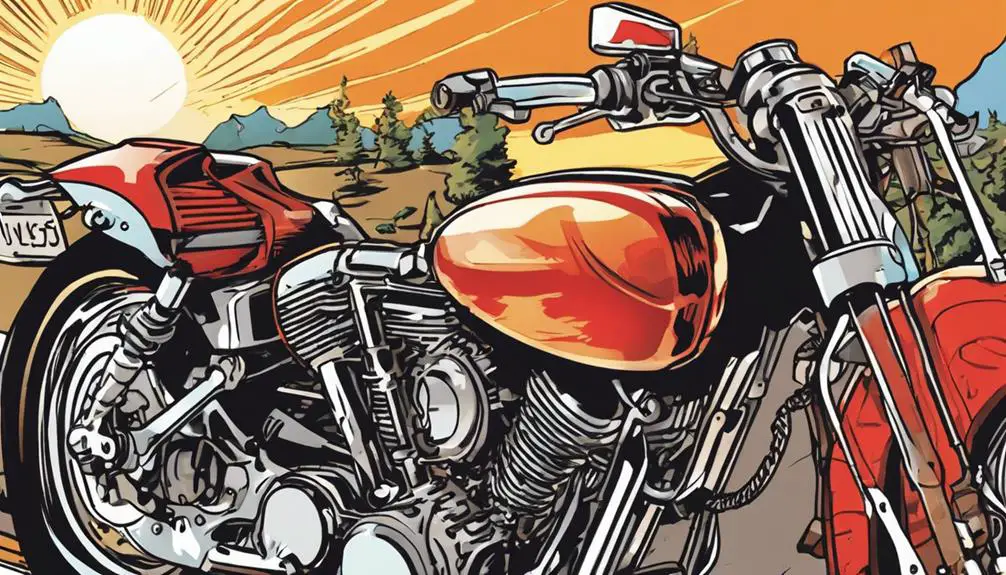
Fuel quality plays an essential role in your motorcycle's performance and longevity, so choosing the right gasoline can make a significant difference.
It's vital to understand that not all fuel is created equal. Higher-quality fuel can lead to better combustion, which translates to more power and smoother rides.
Here are three tips to help you select the best fuel for your ride:
- Check the Octane Rating: Always use fuel with the recommended octane rating for your bike. Higher octane fuel can prevent knocking and optimize engine performance.
- Look for Additives: Opt for fuels that contain detergents and additives. These can help clean your engine and maintain performance over time, reducing carbon buildup and enhancing efficiency.
- Avoid Ethanol Blends: Whenever possible, steer clear of high-ethanol fuels. Ethanol can attract moisture and lead to engine issues, which can hinder your freedom on the road.
Aerodynamics
Aerodynamics greatly affects your motorcycle's speed, stability, and fuel efficiency, so optimizing your bike's design can enhance overall performance. When you ride, you want to cut through the wind effortlessly. By tweaking your bike's fairings and windscreen, you can reduce drag and make your ride smoother. Consider a more streamlined body shape; it'll not only look sleek but also help you reach higher speeds with less effort.
Pay attention to your riding position, too. Leaning forward decreases your wind resistance, allowing you to slice through the air. Even small adjustments, like shifting your weight or tucking in your elbows, can make a noticeable difference in how your bike handles.
Don't forget about accessories. Choosing the right helmet and riding gear can also reduce drag. Lightweight materials and aerodynamic designs can keep you feeling liberated as you ride.
Maintenance Practices
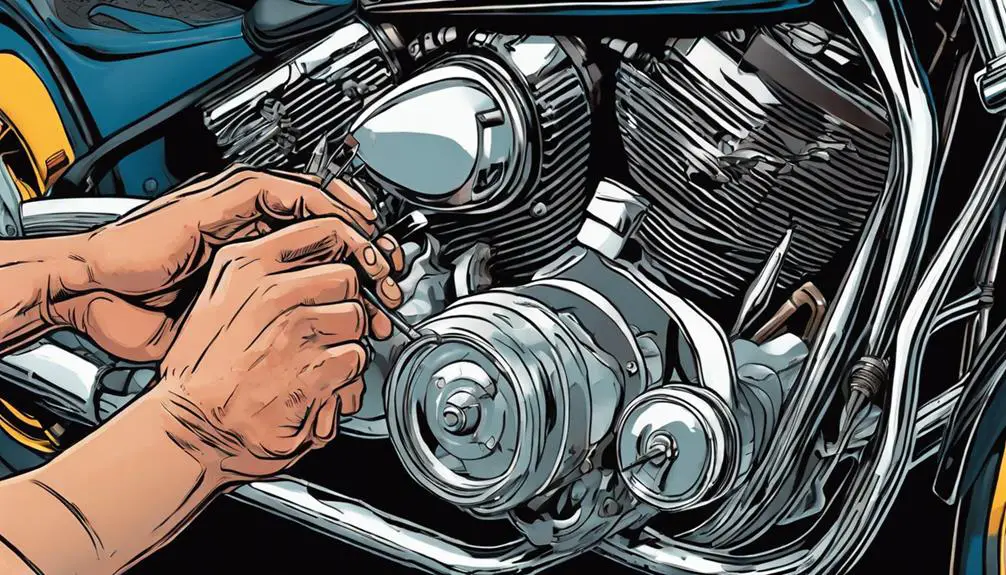
Regular maintenance is crucial to keep your motorcycle running smoothly and to enhance its overall performance. By staying on top of a few key practices, you can guarantee you're riding at your best while enjoying the freedom that comes with the open road.
Here are three crucial maintenance practices to adopt:
- Fluid Checks: Regularly inspect and change your oil, coolant, and brake fluid. Clean fluids keep your engine and brakes in peak condition, enhancing performance and safety.
- Tire Maintenance: Check tire pressure and tread regularly. Properly inflated and well-maintained tires improve handling and grip, allowing you to navigate any curve with confidence.
- Chain Care: Keep your chain clean and properly lubricated. A well-maintained chain reduces wear and tear on your bike, improving acceleration and overall efficiency.
Riding Style
Your riding style considerably impacts your motorcycle's performance and can make a world of difference in how you handle various road conditions. Embrace a fluid, confident approach that allows you to connect with your bike. Lean into corners with purpose, using your body weight to guide your motorcycle rather than relying solely on the handlebars. This technique enhances stability and responsiveness, letting you carve through twists and turns effortlessly.
When accelerating, don't just twist the throttle; feel the power beneath you. Gradual, controlled acceleration can provide better traction, especially on slippery surfaces. Likewise, practice smooth braking techniques. Abrupt stops can unsettle your machine, while gentle, progressive braking keeps you in control and guarantees a smooth ride.
Adjust your riding style to the environment. Tackle city streets with agility, and open highways with a more relaxed stance. Listen to your instincts—riding is about freedom, and your style should reflect that. Experiment with different techniques and find what resonates with you.
Ultimately, the more in tune you're with your motorcycle, the more liberated and exhilarating your ride will be.
Gear Ratios
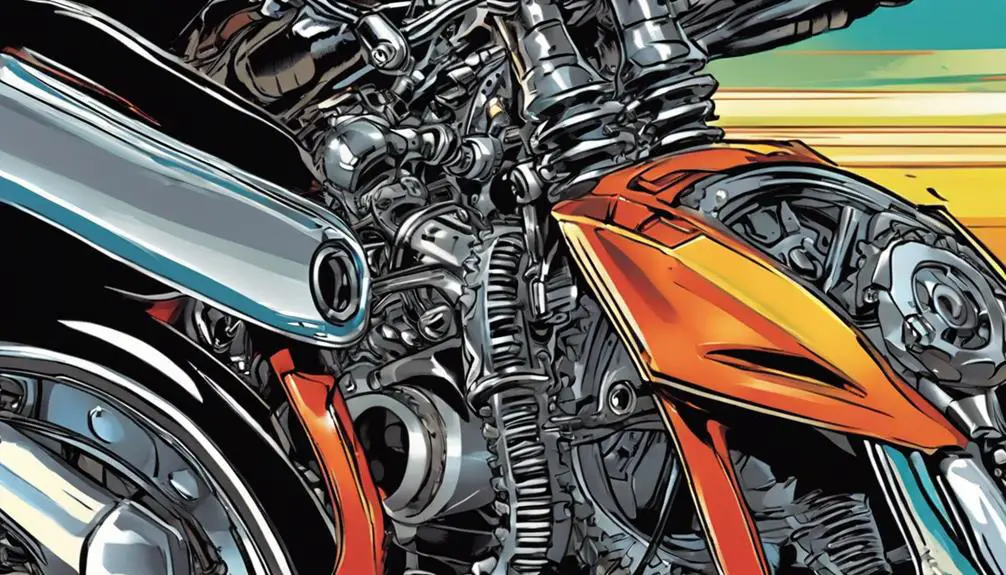
Understanding gear ratios can greatly enhance your riding experience by optimizing the power delivery and responsiveness of your motorcycle. Gear ratios determine how power is transferred from the engine to the wheels, affecting acceleration, top speed, and overall performance. By tuning these ratios, you can liberate the freedom of the open road like never before.
Here are three key aspects to evaluate when adjusting gear ratios:
- Acceleration vs. Top Speed: Lower ratios provide quicker acceleration, ideal for spirited rides and urban commuting. Higher ratios yield better top speed, perfect for highway cruising.
- Terrain Adaptability: If you often ride in varied terrains, assess ratios that offer balance—enough torque for climbing while still maintaining speed on flat roads.
- Rider Preference: Every rider has a unique style. Test different ratios to see what feels best for your riding habits, whether you crave that exhilarating rush or smooth, steady cruising.
Electronic Aids
Electronic aids can greatly boost your riding experience by enhancing control, safety, and performance on the road. These cutting-edge technologies, like traction control, anti-lock braking systems (ABS), and ride-by-wire throttle, help you tap into your bike's full potential.
Imagine carving through corners, knowing your traction control's got your back, preventing those unwanted slides. With ABS, you can brake hard without fear of losing control, allowing you to ride with confidence. Plus, ride modes let you customize your bike's performance to match your mood and the conditions. Want to cruise in relaxed comfort? Switch to touring mode. Feeling adventurous? Go for sport mode and release that adrenaline.
But it's not just about performance; it's about freedom. By reducing the risk of accidents and improving your handling, electronic aids give you the liberation to ride more boldly. You're not just a rider; you're a master of the road.
Embrace these aids, and let them empower your journey. They're tools designed to enhance your experience, not replace your skills. So, keep your focus sharp, and enjoy the ride knowing you've got advanced tech helping you conquer every twist and turn.
Frequently Asked Questions
How Do Weather Conditions Affect Motorcycle Performance?
Weather conditions play a vital role in your motorcycle performance.
Rain can reduce traction, making your tires slip, while strong winds can push you off course.
Extreme heat may cause overheating, affecting engine efficiency.
Cold weather can lead to stiff components, impacting handling.
You've gotta stay alert to these changes, adapting your riding style to guarantee safety and maintain control.
Embracing the elements can enhance your riding experience, but awareness is key for liberation on the road.
Can Rider Experience Influence Motorcycle Handling?
Imagine riding a wave on a surfboard; the more you practice, the better you balance.
Similarly, your experience as a rider directly influences motorcycle handling.
With each twist of the throttle and lean into a turn, you develop a connection with your bike.
Skilled riders instinctively know when to brake or accelerate, enhancing their control.
What Role Does Rider Posture Play in Performance?
Rider posture plays an essential role in performance.
When you maintain a relaxed and balanced position, you enhance your control and responsiveness.
Leaning forward can improve aerodynamics, while a straight back helps with stability.
If you shift your weight correctly during turns, it allows for smoother handling.
How Does Tire Pressure Impact Motorcycle Stability?
Tire pressure plays an essential role in your motorcycle's stability.
When you keep it at the recommended level, you enhance grip, control, and handling.
Low pressure can cause wobbling and reduce responsiveness, while high pressure might lead to a harsh ride and less traction.
By regularly checking and adjusting your tire pressure, you guarantee a smoother, more confident ride.
Does the Type of Riding Gear Affect Performance?
Yes, the type of riding gear definitely affects your performance.
When you wear gear that fits well and offers adequate protection, you feel more confident on the road. Lightweight materials can enhance your mobility, while breathable fabrics keep you comfortable during long rides.
On the other hand, bulky gear can restrict your movements, making it harder to control your bike.
Conclusion
By following these ten tips, you can reveal your motorcycle's true potential, much like a master unveiling the secrets of a legendary steed.
Whether it's fine-tuning your engine or keeping your tires in top shape, every detail counts towards enhancing your ride.
So, gear up, embrace the road ahead, and remember that the journey isn't just about the destination—it's about how well you perform along the way.
Happy riding!